Sparta, Georgia, is a town in Hancock County about halfway between Atlanta and Augusta, not far from Interstate 20. It’s a very small county, with less than 9,000 people. It’s not a destination, and it’s not really on the road from any place to any other place.
Before the Civil War, Hancock County was one of the wealthiest counties in Georgia. That wealth was built literally on the backs of slaves, but when slavery ended, and later, when cotton’s reign ended, the county sank into poverty. Those slaves and their descendants inherited virtually nothing of the wealth. Today, Hancock falls near the bottom of any list of average income, whether for the state of Georgia or the entire United States. Three of every 10 people there live below the poverty level. For blacks, who make up more than 70 percent of the county’s population, the poverty rate is more than 37 percent. About the same number of people in the county have less than a 9th grade education as have a college degree. The major employers are the county school system and a state prison.
Over the decades, life in Sparta and Hancock County changed slowly, if at all. Blacks were no longer slaves, but they were disenfranchised. Whites, despite being in the minority, held unquestioned power. As in virtually every Southern community, there were no elected black officials. Schools were segregated. There was only limited opportunity even for most whites in Hancock County, and even less for blacks.
But a change was coming.
In 1934 John McCown was born. The improbable trajectory of his life started in the Pee Dee region of South Carolina and ended in Sparta. He hit Hancock County like a massive meteorite, causing strife and upheaval, overturning the old way of life, bringing hope, change, and, in the end, scandal and dashed hopes.
McCown lived as a youth in South Carolina for a while, then moved to Harlem to be with his mother. From there he entered the Air Force, where he stayed for just under 10 years. His civil rights activities started in the Air Force and continued to Selma, Alabama, with Martin Luther King Jr and Stokley Carmichael. Of the two, McCown’s political philosophy was probably closer to Carmichael’s than King’s. He moved through the South, taking different positions in different places. He was in Savannah, Hilton Head, Atlanta, Athens, Ga. His goal became black political power, and, eventually, Sparta and Hancock County presented themselves as an ideal place to realize his goal.
Hancock County was, perhaps, a little different from many Southern counties. Hancock’s delegates to the Georgia state secession convention voted against secession. Hancock was said to be the only county in Georgia that did not have a lynching, which, one has to admit, is a pretty low bar for humanitarianism. But Hancock County’s black residents suffered the same oppression in almost every way that blacks did throughout the South. Whites held essentially absolute political power. But there were seven black people for every three whites, and that must have seemed a perfect place to McCown for blacks to exert their political power.
But McCown was pursuing more than political power for the black population; he wanted economic power as well. He came to Hancock County in 1966 or 1967. For the next nine years he organized, promoted, and conned his way into getting millions of dollars of private and government funding for his projects, run through the East Central Committee for Opportunity (ECCO). He got a concrete block plant, a huge catfish farm, low-cost housing, a movie theater, airplanes, an “international” air strip, and, at some point, a bar through ECCO. Along the way he got a lot of blacks registered to vote and, eventually elected to office in the county.
For the whites in a backwater like Hancock County, it must have seemed like their world had been turned upside down. For them, their supremacy was like water to a fish. They swam in it and took it entirely for granted. No wonder, then, that some wanted to resist, especially since McCown was, let’s say, abrasive in his dealings with the white power structure. At one point, the Sparta police department got 10 machines guns (or 12, depending on where you read it) for its six-man (or five-man) force. McCown upped the ante, buying 30 machine guns for his group.
There was gunfire in the county, a couple of buildings were burned. It was bad enough that Jimmy Carter, then governor of Georgia, came to Hancock County to try to calm things down.
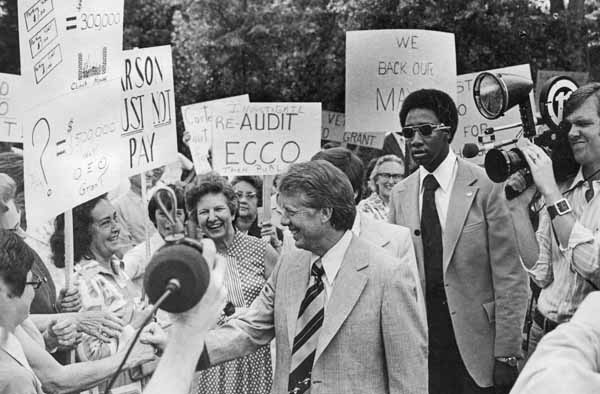 And then there were the investigations into how all that money was being spent. The money dried up. People were indicted. Business enterprises failed. It must have seemed to McCown that his world was in a slow-motion collapse. One evening he went with a few friends to the bar, which, it was said, was the only ECCO enterprise that made money. There McCown and his friends did some drinking. And then, they decided to take a plane ride.
And then there were the investigations into how all that money was being spent. The money dried up. People were indicted. Business enterprises failed. It must have seemed to McCown that his world was in a slow-motion collapse. One evening he went with a few friends to the bar, which, it was said, was the only ECCO enterprise that made money. There McCown and his friends did some drinking. And then, they decided to take a plane ride.
It must have seemed like a good idea, despite the fact that McCown did not have a pilot’s license, and was, besides that, drunk.
It was not. The plane crashed, killing McCown and two others.
McCown had come to Hancock County to change things. I think he wanted to build a new social structure where blacks had political and economic power. Unfortunately, I think McCown had the will to build but the ability only to destroy. It was like trying to renovate a house; it’s much easier to do the tear-down than the construction. In the end, he did destroy the existing power structure, and in doing that, he left a foundation that the black population could build on. But as for the rest, it seems that it was all a failure. He obviously talked a very good game. He brought in millions of dollars to the county. Maybe if he had had someone else working with him, someone who knew more about building, his legacy would have been different.
Unfortunately for both whites and blacks in Hancock County, the economic situation has not changed much. The last reference I can find to any of the ECCO undertakings was a real estate company ad offering the ECCO catfish farm for sale.
It’s easy to conclude from all the coverage of McCown that he was a scoundrel, and an angry man whose main goal was to stir up things – an outside agitator, as they used to say. But that’s the white man’s take on black anger. I don’t think it’s unreasonable for a black man born in the 1930’s in the South to be a little angry. Or even a lot angry. I don’t doubt that John McCown was a flawed man, but he had heroic visions. Perhaps his flaws kept him from achieving the vision he undoubtedly had. Perhaps those flaws led to his own downfall. It’s the classic Greek definition of the tragic hero.
John McCown’s home in Hancock County.
Although John McCown had another elaborate home built in Hancock County, he also had an older house, now abandoned. These are some photographs of that house that appeared on the blog abandonedsoutheast.com, used with the gracious permission of the owner, Leland Kent.
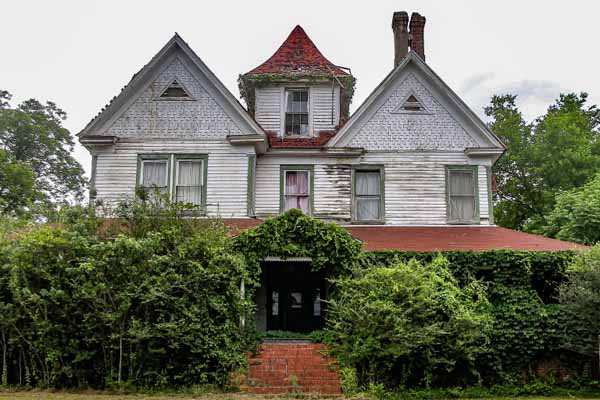
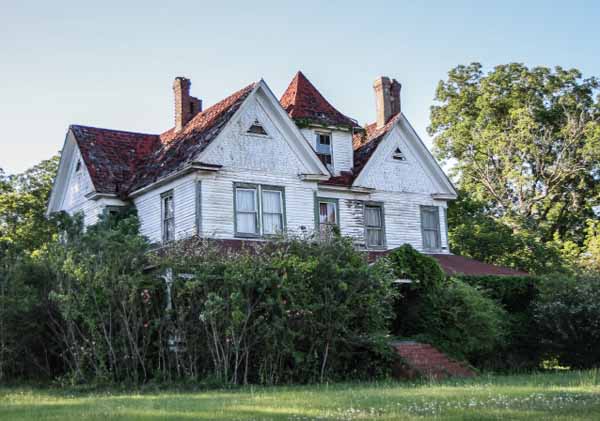
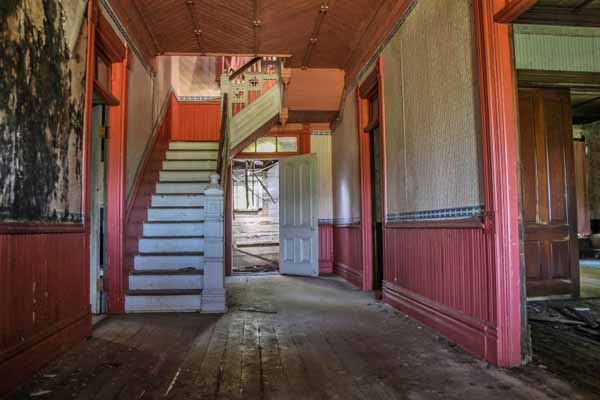
And, in the yard, a memorial.
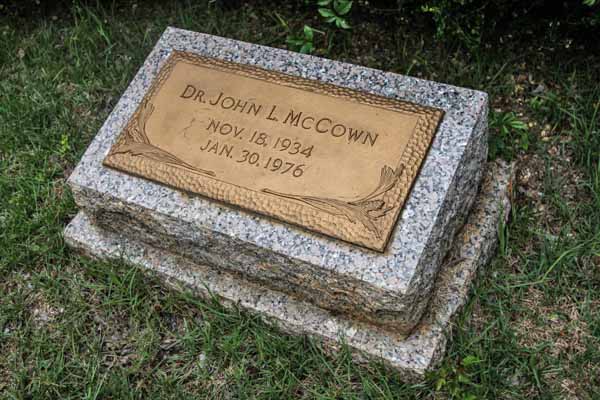
Between 1973 and 1976 I was working on the state desk at The Augusta Chronicle. My beat was essentially every place where the newspaper circulated outside of the city of Augusta. Sparta was too far away; no one there subscribed to the Chronicle or its sister paper, the Herald. So a lot went on there that we never heard about. Eventually it was too big a story to ignore just because no one in Hancock County read our paper. It was news in Atlanta and New York. Surely it must be news in Augusta, too. A lot had gone on before I started writing stories and taking pictures. My regret from those days is that I didn’t try to learn more about him.
The photographs, except for the one of Jimmy Carter, are from Leland Kent’s abandonedsoutheast.com blog (https://abandonedsoutheast.com/2017/06/06/johns-house/), which also has a lot of other interesting things. I took a lot of information from a biographical history class final essay (ericschirmer.files.wordpress.com/2014/03/black-boss-john-mccown.docx) with the kind permission of its owner, Eric Schirmer. At one point in his essay, Schirmer writes, “[McCown] told a reporter from The Augusta Chronicle, ‘I’m not a violet man but if someone stands in my way, I believe I should kill them.’” Was that me?
I should note that this is just the most superficial gloss of the story of John McCown and Hancock County. I’m not sure the full story is easy to find. Some of the early articles about ECCO from as far away as New York may be overly favorable, not to say gullible. Some of the later articles may be slanted in the opposite direction. It’s a complex story, and probably one that will never be told in full.
There is a book about him (Black Boss), which I have not read. The reviews of the book are interesting. It’s clear that John McCown remains a controversial figure, mostly reviled by whites, and some in the black community as well. I missed my opportunity to at least try to find the truth when I covered his story (shallowly, I fear) as a newspaper reporter at the time. There seems to be no doubt that money was misspent by McCown and ECCO. Greed? Misplaced sense of entitlement? Carelessness? Don’t-give-a-damn-dig-in-and-help-yourself? There is no doubt at all that the dream he promised or peddled was not much more substantial than an actual dream, and almost no one in Hancock County derived any lasting benefit out of all the turmoil. Maybe he at least woke some people up to possibilities. Maybe not.